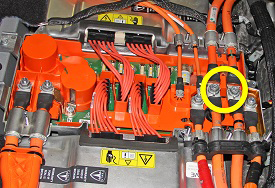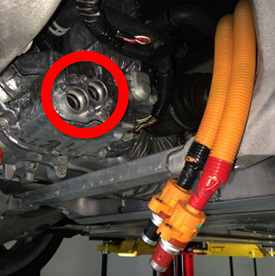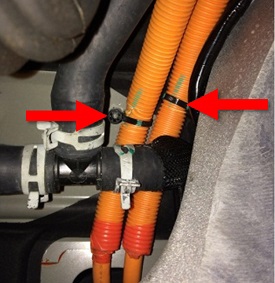Tesla Model S: HV Harness - Rear Drive Unit to HVJB
Warning: Only technicians who have been trained in High Voltage Awareness are permitted to perform this procedure. Proper personal protective equipment (PPE) and insulating HV gloves with a minimum rating of class 00 (500V) must be worn any time a high voltage cable is handled. Refer to Tech Note TN-15-92-003, "High Voltage Awareness Care Points" for additional safety information.
Special tools required for this procedure:
| Supplier | Part Number | Description |
| Tesla | 1051629-00-A | Cap, Connection, Rosenberger, H4Z001-000/52 |
- Position the vehicle in preparation for raising it, but keep the vehicle at ground level at this time.
- Perform the vehicle electrical isolation procedure (refer to procedure).
- Remove the high voltage junction box (HVJB) cover (refer to procedure).
- Remove the nuts (x2) that secure the B+ and B- HV cables to the
HVJB (torque 9 Nm).
Note: It is not necessary to replace the fastener(s) after it is removed. The threaded area has a reusable dry sealant, which looks similar to adhesive patch material.

- Remove the bolt that secures the HV fuse ground strap to the body (torque 5.5 Nm).
- Release the edge clips (x2) that secure the HV harness to the body of the vehicle.
- Carefully release the grommet from the body.
- Remove the mid aero shield (refer to procedure).
- Remove and discard the screws (x4) that secure the B+ and B- HV
cables to the rear drive unit (torque 7 Nm).

- Install protective caps over both HV cables to protect the terminals and seals.
- Release the cable ties (x2) that secure the HV cables to the
body of the vehicle.

- Lower the vehicle.
- Working from inside the vehicle, remove the HV harness.
Installation procedure is the reverse of removal, except for the following:
Caution: Replace all Patchbolt(s).
- Apply P-80 emulsion to the cable grommet and ensure that grommet is fully seated.
- Apply P-80 emulsion to the connector seals on the HV cables
before securing the HV cables to the drive unit.
Caution: Do not apply P-80 emulsion to the HV terminals.
.png)

